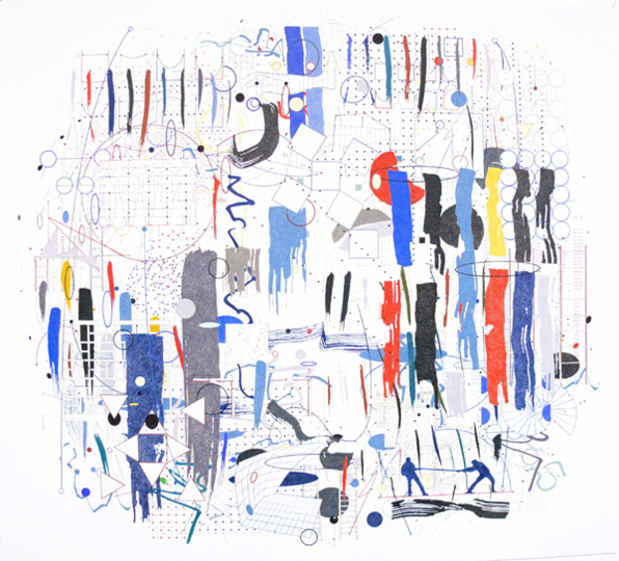Paul Glabicki “Relativity”
Kim Foster Gallery

This event has ended.
Readings on Albert Einstein’s theories of relativity provided a catalyst for this series of drawings by Paul Glabicki. Einstein’s notions of time and space collide and interact with the artist’s own ongoing interest in time, simultaneity, semiotics, and multi-layered composition – complex images and visual information obsessively and systematically accumulated over time. Einstein’s theories are often conveyed by vivid imagery of simultaneous motion, comparisons of moving objects within confined spaces, time dilation and paradox, parallel observations, and comparative points of view – both intimate and vast. In this world, two events, simultaneous for one observer, may not be simultaneous for another. It’s a world that offers unfamiliar, surprising, but measurable complexity, and challenges our perception and orientation of order, time and reality – objectives that are, in many ways, shared by the artist.
Each drawing in the RELATIVITY drawing series is a relentless accumulation of images, data, form and color progressively added in pairs – one element in relation and relative to another. Each pair of elements is a singular event, contrast, or juxtaposition – some simple and formal (large/small, left/right, reversals, contrasts, foreground/background), others more complex (fact/fiction, two versions of similar data, past/present, opposites, comparisons). Sets of data, marks, and detail are created or arranged by choice of the artist, or selected, extracted or transcribed from found or researched material. Einstein references appear in each drawing, colliding with other pairs of images and data relating to other notions of relativity and relative associations (proportion, growth, size, color). Dual processes and representation also factor into the construction of the compositions. In a parallel activity prior to the making of the drawings, hundreds of actual ink brush strokes were made and categorized, and then systematically selected, paired, drawn, and added to the final drawing space. Mechanical technique (assisted by drafting tools) is used in relation to freehand drawing or traced detail. The completed drawing becomes a unique configuration and multi-layered collage, a record and architecture of information and visual form constructed in pairs, at once simultaneous, mysterious, and, depending on the observations of the viewer, a multi-layered reality or record to be read, discovered and explored at each viewing.
Paul Glabicki is best known for his experimental film animations that have appeared at major film festivals, as well as national and international museum exhibitions. His animation work in film has been carefully crafted by means of thousands of hand-drawn images on paper – each drawing representing both a frame of film and a unique complete work on paper. His film works have been widely screened at such prestigious sites as the National Gallery of Art, New York Film Festival at Lincoln Center, the Cannes Film Festival, the Museum of Modern Art, Whitney Museum of Art in New York (Whitney Biennial), and the Venice Biennale. He has received numerous awards, grants, and fellowships, including a Guggenheim Fellowship, grants from the National Endowment for the Arts, the American Film Institute, and several grants from the Pennsylvania Council on the Arts.
[Image: Paul Glabicki, RELATIVITY #6, 2013 Graphite pencil, prismacolor pencil, ink, acrylic on paper 31 1/2 x 34 1/2 inches]
Media
Schedule
from January 09, 2014 to February 15, 2014